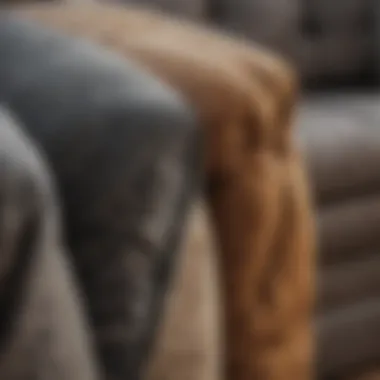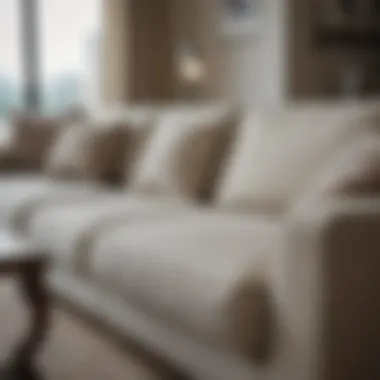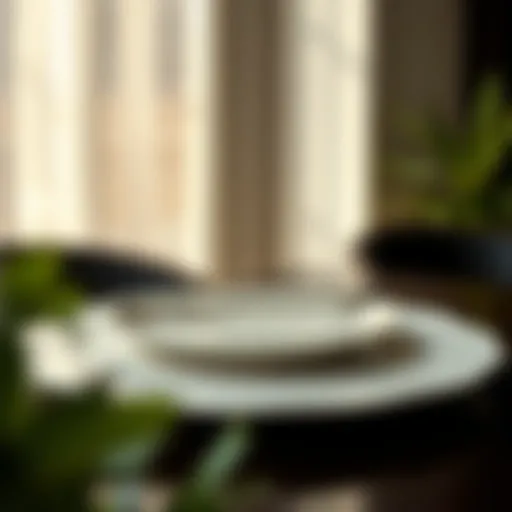Affordable Fabric Sofas: A Complete Buying Guide


Intro
When one thinks of furnishing their home, it's easy to get swept up in visions of luxurious materials, designer pieces, and high costs. Yet, in today’s market, more and more people are realizing that affordable fabric sofas can provide style and function without sending their budget off the deep end. These sofas not only cater to the wallet-conscious but also offer an opportunity to express personal style.
With the right choices, homeowners, designers, and even DIY enthusiasts can find that perfect balance of quality, comfort, and aesthetics. In this guide, we'll explore key aspects of affordable fabric sofas, from understanding various styles to practical selection tips, ensuring that even on a budget, anyone can create a warm, inviting, and chic living space that reflects their unique taste.
So, let's dive into the world of fabric sofas where style meets budget-friendly living, making your home not just a place to crash but a true reflection of who you are.
The Value Proposition of Fabric Sofas
The discussion around fabric sofas is often anchored in the conversation about value—something every savvy shopper considers, especially in the world of furniture. When it comes to fabric sofas, the value proposition encompasses various critical considerations ranging from comfort to style, not to mention cost-effectiveness. Understanding these dimensions can empower consumers to make choices that align with both their aesthetic preferences and their financial constraints.
Understanding Fabric Sofa Features
Fabric sofas are not a monolithic category; they come with a variety of features that cater to different tastes and lifestyles. At the core of their appeal lies comfort—many fabric sofas, especially those with well-cushioned seats, invite you to sink in and relax after a long day. The fabric itself can significantly influence your seating experience. For instance, soft cotton or linen can create a laid-back atmosphere, whereas denser materials like microfiber may offer a more structured feel.
Additionally, many fabric sofas come equipped with removable covers, making maintenance a breeze. This feature allows homeowners to clean the sofa more easily, which is a significant plus for family settings or homes with pets. A fabric sofa’s design can also feature various additional elements—such as throw pillows or unique armrest shapes—that add a bit of personality to your space.
Cost Efficiency and Longevity
When comparing fabric sofas to leather or other materials, fabric options often come out ahead in terms of cost efficiency. Sofas made from fabric typically have a lower upfront cost, meaning budget-conscious shoppers can find high-quality options without breaking the bank. Additionally, the versatility of fabric allows for a broader range of designs and colors, which can help in seamlessly fitting the sofa into diverse home decors.
However, it’s not just about the initial investment. Longevity is another aspect worth examining. While some might perceive that cheaper fabric translates to shortcuts in durability, that is not always the case. With the right fabric—think high-quality polyester or tightly woven cotton—a fabric sofa can withstand years of use without losing its shape or color. The trick lies in choosing the right fabric and understanding how to take care of your purchase.
In the end, homeowners should keep an eye on both quality and price when making their decision. A well-chosen fabric sofa that suits personal needs offers enduring comfort and style, making it a worthwhile investment.
"Investing in a quality fabric sofa can elevate not only your living space but also your everyday comfort."
By weighing these various facets of the fabric sofa's value proposition, consumers can arm themselves with the knowledge needed to navigate their choices wisely and make informed decisions that align with both their budgets and their lifestyles.
Types of Fabric Used in Sofas
Understanding the different types of fabric used in sofas is essential for anyone looking to furnish their living space. The fabric choice can influence not just the aesthetics, but also the comfort, durability, and maintenance of the sofa. When it comes to affordable options, knowing the distinctions between fabrics will help you to make informed choices that balance style with practicality. From natural fibers to synthetic blends, each category carries its own set of benefits and drawbacks.
Cotton and Linen
Cotton and linen materials are often lauded for their natural feel and breathability. These fabrics have a texture that feels soft against the skin, making them an inviting choice for cozy lounging.
- Durability: While cotton is known for its strength, linen has a reputation for being even stronger, although it can wrinkle more easily.
- Easy Maintenance: Both cotton and linen typically breathe well, which means they are cool to sit on during hot days. Spot cleaning is usually straightforward, although linen might require more careful handling to maintain its initial luster.
- Affordability: Often, cotton is more readily available and can be cheaper than other high-end fabrics, which makes it an attractive option for budget-conscious buyers.
Polyester and Microfiber
Polyester and its cousin, microfiber, offer many perks that make them popular choices for fabric sofas, especially in busy households.
- Stain Resistance: These synthetic fabrics are quite adept at resisting stains, making them an ideal choice for families with children or pets. They tend to repel spills, so cleaning up after the little ones is less of a headache.
- Durability: Polyester is tough, meaning it can withstand daily wear and tear. Microfiber, being a finer weave of polyester, adds an extra layer of softness while maintaining that durability.
- Cost-Effectiveness: Typically, these fabrics fall on the more affordable side of the spectrum, making them accessible options for homeowners looking to furnish their space without overspending.
Blends and Synthetic Options
Choosing a blend or synthetic fabric can open up a world of possibilities when selecting a fabric sofa. These materials often combine different fiber types, delivering the best of both worlds.
- Versatility: Blends can provide the comfort of natural fibers alongside the durability of synthetics. For instance, a polyester-cotton blend often ends up being stronger and easier to maintain than pure cotton.
- Limited Fading: Many synthetic fabrics resist fading better than natural fibers, so bold colors tend to hold up longer, preserving your sofa's original look over time.
- Broad Range of Styles: With advancements in fabric technology, synthetic options can mimic the appearance and texture of traditional fabrics, allowing greater design flexibility without the maintenance concerns typically associated with them.
"The right fabric can transform not just the look, but the feel of your entire living space."
When navigating the sea of options, keep in mind how each fabric type fits your lifestyle and aesthetic preferences. Choosing wisely can elevate not only the comfort level of your sofa but also enhance the overall vibe of your home.
Styles of Fabric Sofas
When it comes to fabric sofas, the style is just as important as the materials and functionality. A sofa can become the centerpiece of a room, influencing the overall aesthetic and mood of the space. From modern designs that lend a sleek touch to classic styles that exude timelessness, variety abounds. Selecting the right style can transform a living area from bland to breathtaking, making it crucial for buyers to consider how the sofa will fit into their existing decor.
Modern Aesthetics


Modern fabric sofas typically emphasize clean lines, minimalism, and a plethora of bold colors or neutral tones. This style can foster a sense of spaciousness and calm, perfect for those who appreciate contemporary themes. Materials like velvet or tightly woven fabrics are often favored due to their sleek visual appearance.
Benefits of modern aesthetics include:
- Versatile and easy to accessorize
- Ideal for open-plan living spaces
- Tends to blend well with other decor styles
For instance, a low-profile fabric sectional can provide ample seating while harmonizing beautifully with geometric patterns and metallic accents, creating that quintessential modern look. One might also find that shades of gray or mustard yellow can add a sprinkle of life without overwhelming the space, giving you both personality and sophistication.
Classic Designs
Classic design fabric sofas embody elegance and formality typically characterized by features like tufting, rolled arms, and traditional floral or paisley patterns. This style harks back to the rich heritage of furniture craftsmanship and often incorporates materials such as damask or cotton blends.
Considerations for classic designs include:
- Timeless appeal making it suitable for both modern and vintage homes
- Often more comfortable due to their plush structure
- Appeals to a wide range of tastes
For example, a chesterfield sofa in a rich navy blue fabric not only maintains its allure but also creates a conversation piece that tends to evoke nostalgia. Using rich, deep colors alongside rich textures can manifest a cozy, inviting atmosphere in your living room.
Eclectic and Bohemian Touches
If your taste dances on the wild side of furnishings, then eclectic and Bohemian styles may resonate with you. This approach embraces a mix of textures, colors, and patterns, often celebrating individual expression and creativity. Fabric sofas in this style showcase vibrant prints and mixed upholstery, bringing warmth and whimsy to any setting.
Key features of eclectic sofas include:
- Freedom to combine various styles and decors
- Unique, one-of-a-kind pieces that tell a story
- A playful mix of colors and patterns enhancing visual interest
For instance, a patchwork fabric sofa can serve as a statement piece that draws the eye, while a collection of mismatched cushions wrapped in bold prints can effectively bring the room together. This choice allows homeowners to have an ever-changing canvas to express themselves.
"When choosing a sofa, consider how the style aligns with your personality and lifestyle, as it will reflect in the overall feel of your home."
Selecting the Right Fabric Sofa
Choosing the right fabric sofa is not just about picking a piece of furniture to plop down on. It’s about finding something that blends aesthetics with functionality, all while managing your budget. The right sofa can anchor your living space, providing comfort while serving as a design statement that reflects your personal style. Yet, many homeowners jump into purchasing without considering the full scope of their needs, preferences, and the environment the sofa will inhabit. This section dives deep into the criteria to consider when undergoing this important selection process.
Identifying Your Needs
Before you start browsing through furniture stores or scrolling through online catalogs, you must put some thought into what you truly need. Think about the primary function of your sofa. Are you after a comfy spot for family movie nights, or is this more for entertaining guests?
Consider the following elements:
- Size and Space: Measure your room to determine how much space you have to work with. A bulkier sofa may dwarf a tiny living room, while a sleek, minimalistic piece might get lost in a spacious area.
- Usage Frequency: If you have pets or small children, durability should be at the forefront of your mind. Fabrics like microfiber or treated polyester may be better suited for high-traffic living areas.
- Style Preferences: Decide on whether you want something more traditional or modern. Your sofa should harmonize with the rest of your décor instead of sticking out like a sore thumb.
- Comfort Level: Always test the seating! What feels cozy to you may not to others. Sit and lounge a bit, possibly even bringing a friend to get an additional perspective.
By methodically identifying these essential needs, you can narrow down your options and avoid unnecessary purchases that could turn into buyer’s remorse later on.
Evaluating Quality vs. Price
As a savvy shopper, you know that the lowest price often comes with trade-offs. Understanding the value of quality is key when selecting a fabric sofa. You don’t want to invest in something that will wear out faster than you can say "I need a new sofa."
Here are valuable points to contemplate:
- Frame Construction: A strong frame can make a world of difference. Sofas made with solid hardwood frames tend to last much longer than their particleboard counterparts. They might cost more, but it’s often a worthwhile investment for longevity.
- Fabric Quality: Various fabrics come at different price points. Natural fibers like cotton and linen are generally breathable and cozy but may not hold up as well as synthetic fibers. Polyester or blends might cost less but are often more durable.
- Cushioning: The filling of the cushions matters—a sofa with high density foam or down-wrapped options will maintain its shape over time. Test cushions for firmness and resilience.
- Warranty: A warranty can signal a company’s confidence in their product. Look for brands that offer a substantial warranty on their sofas, as it often indicates they stand behind the quality of their materials and craftsmanship.
Ultimately, the goal is to strike a balance—ensure your buzzing wallet isn’t the driving force behind your purchase. Much like a fine wine, sometimes you need to pay a little more for quality that lasts.
Sustainability Considerations
In this day and age, it’s hard to overlook the importance of sustainability. Consumers are becoming more aware of the environmental impact their purchases might have. When selecting a fabric sofa, keep sustainability in mind to make more responsible choices.
Here are some considerations:
- Material Source: Look into the fabric choices. Organic cotton, for instance, is a much better option than conventional cotton, given that it is grown without harmful pesticides.
- Manufacturing Practices: Research brands that prioritize eco-friendly manufacturing processes. Companies that use low-impact dyes or recycled materials tend to have a smaller carbon footprint.
- Durability and Lifespan: A durable sofa is not only a better investment but reduces the likelihood of you having to toss it out in a few years. A longer lifespan translates to less waste.
- Recyclability of Materials: Check if the brand offers products made from recyclable materials or has a recycling program for when the sofa finally reaches the end of its life.


Treading lightly on the Earth while investing in your living space is possible. A thoughtful selection can leave a minimal footprint while offering a piece that enhances your home for years to come.
"Buying a sofa doesn’t just fill a room; it’s about crafting your living space in a way that reflects your values and aspirations."
By keeping these key aspects in mind, selecting the right fabric sofa can be a fulfilling endeavor that satisfies not only your immediate needs but also aligns with broader values like sustainability and durability.
Where to Find Cheap Fabric Sofas
Finding a budget-friendly fabric sofa can feel like hunting for a needle in a haystack. However, understanding the lay of the land helps ease the process. It’s essential to know where to look for these treasures, as each avenue comes with its own set of pros and cons. In the age of online shopping, local stores, and even second-hand stores, the options are more varied than ever.
Whether you are a homeowner on a budget, a student in a cozy apartment, or someone simply wanting to refresh a living space, knowing where to find affordable fabric sofas can save both time and money. Let’s dive deeper.
Online Retailers
In today’s digital world, online retailers have become a go-to for many. Websites like Wayfair, Amazon, and Overstock offer a plethora of options that you can scroll through at your leisure. One major advantage of shopping online is the sheer variety. You could easily find the ideal style, fabric, and color that suits your taste and budget.
- Convenience: You can shop anytime, comfy in your pajamas.
- Comparison Shopping: Easily compare prices and styles across multiple sites.
- Customer Reviews: Gain perspective from other buyers regarding comfort and durability.
However, you need to be cautious. What looks good on the screen might not always translate into real life. Pay close attention to fabric descriptions and dimensions. Also, the shipping costs can chicken out your savings, so read the fine print carefully.
Local Furniture Stores
Venturing into local furniture stores presents a different kind of experience. Unlike online shopping, you can touch, feel, and actually sit on the sofas. This tactile interaction can be crucial for such an important piece of furniture. Local shops sometimes have exclusive deals that aren’t advertised online, seeing as they want to clear out older stock to make room for new items.
- Personalized Service: It’s easier to ask questions and get immediate feedback from sales staff.
- Immediate Availability: You can take it home the same day, or at least find out shipping details.
- Support Local Businesses: Purchasing from local stores helps your community.
Nonetheless, the selection may not be as vast compared to online marketplaces. If you’re after something very specific, it might require more effort.
Second-Hand Options
There is a certain charm that comes with second-hand items. Not only are they often cheaper, but they can also have a story behind them. Check out places like thrift stores, online classifieds, or community groups on social media. You'd be surprised by what you can find.
- Unique Finds: Every piece is one of a kind, adding character to your home.
- Eco-Friendly Choice: Buying used helps reduce waste and promotes recycling.
- Bargain Prices: You can often negotiate the price, getting yourself an even more appealing deal.
However, expect that condition may vary. Thoroughly inspect the fabric for any wear or damage. A little elbow grease might be needed to restore older pieces but that gives them a personal touch.
Remember, whether you are browsing online, exploring local shops, or hunting for gems in second-hand stores, patience is key. The perfect fabric sofa is out there, waiting for you to scoop it up.
Maintenance of Fabric Sofas
In the realm of affordable fabric sofas, maintenance plays a pivotal role. Not only does it extend the life of your furniture, but it also retains its appearance over time. Imagine shelling out good money for a cozy sofa, only for it to look worse for wear in a few months because of improper care. This section dives into the nitty-gritty of keeping your fabric sofa looking sharp and inviting.
Cleaning Techniques
Regular cleaning is crucial for maintaining your fabric sofa. Dust and dirt can accumulate quickly. A gentle vacuuming once a week can do wonders for removing loose debris. Make sure to use a brush attachment to avoid snagging the fabric. If your sofa is prone to stains, it’s wise to act promptly. Blotta the spill with a clean cloth rather than scrubbing, which could spread the stain or damage the fibers.
For deeper cleaning, consider these methods:
- Spot Cleaning: Using a mild soap solution or a fabric-specific cleaner, dab at a stain gently with a sponge.
- Steam Cleaning: If your sofa allows it, steam cleaning is an effective method to remove grime and kill allergens.
- Dry Cleaning: Some fabrics may require professional cleaning. Always check the care tag and follow the manufacturer’s recommendations.
A suitable cleaning routine not only refreshes the fabric but can also preserve the integrity of the materials, saving you money in the long run.
Preventing Damage
Damage prevention is as critical as cleaning. A few practical tips can aid in avoiding some common pitfalls. Here’s what you should consider:
- Sunlight Exposure: Refrain from placing your sofa in direct sunlight. Over time, UV rays can fade colors and weaken fabric fibers.
- Furniture Protection: Using furniture covers or throws can guard against spills, scratches from pets, and general wear.
- Avoiding Heavy Usage: If you have children or pets, designating a specific area for them can minimize unwanted wear and tear.
- Fluffing and Rotating Cushions: Occasionally fluff and rotate cushions to ensure even wear, extending their life significantly.
Taking these precautions helps keep your sofa as beautiful as the day you brought it home, balancing aesthetics with functionality. By investing a little time in maintenance and care, homeowners can enjoy the cozy embrace of their fabric sofas for years to come.
Comparing Cost and Quality


When diving into the world of affordable fabric sofas, the concept of cost versus quality arises prominently. This balance is crucial for consumers who aim to furnish their spaces economically while ensuring durability and aesthetic appeal. Understanding how to navigate this delicate equation can greatly influence both purchasing satisfaction and long-term usability.
Understanding Price Tags
Price tags often whisper complex tales. At first glance, they might just seem like a number stapled to a piece of fabric. But dig a litter deeper, and you'll find they hold clues about the materials, design intricacies, and longevity of the sofa.
When examining price tags, it's wise to consider:
- Material Quality: Sofas made from higher-end materials, like leather, may cost more but offer durability and style that outlast cheaper alternatives. A cotton blend, while more affordable, may not stand up against the wear and tear over time.
- Brand Reputation: Some brands inflate their prices due to the prestige associated with them. Familiar names might promise reliable quality, but that doesn't always equate to better value. It's often a good idea to research less famous brands that offer comparable quality for a fraction of the price.
- Sales and Discounts: Many retailers have periodic sales, meaning timing your purchase can lead to significant savings. Keeping an eye out for seasonal discounts might just net a fabulous sofa without denting the budget too badly.
Take a moment to reflect, comparing what each price tag represents. It’s not just a figure; it’s a gateway to making an informed choice.
Breaching the Quality Barrier
The phrase "you get what you pay for" is never more true than in the furniture world. However, that doesn’t mean every affordable option is subpar. Here, breaching the quality barrier becomes essential for savvy shoppers.
Achieving this involves:
- Researching Materials: Take the time to assess the specific fabric used. Microfiber, for instance, can offer both longevity and style without hefty costs. Similar research should extend to the frame and cushioning materials, as these aspects are critical to the comfort and life of the sofa.
- Testing the Sofa: If possible, sit on it. Does it feel sturdy? Does the cushion feel durable? The physical experience can often be the best teacher.
- Reading Reviews: Look for feedback from other owners. Various platforms, including forums like reddit.com or furniture review sites, provide insights. Comments from folks who have walked the path can be valuable.
"Quality doesn’t always mean spending a fortune; sometimes, it’s about knowing what to look for."
In summary, the dialogue between cost and quality does not have to be a contentious one. With the right approach, consumers can find fabric sofas that are both budget-friendly and built to last. Paying attention to the underlying factors in price tags and knowing how to penetrate the quality facade creates a powerful strategy for any buyer.
Design Inspirations and Tips
In the realm of interior design, fabric sofas play a crucial role. Their versatility in style and comfort can make or break a living space. Therefore, understanding design inspirations and clever tips is essential for anyone looking to refresh their home ambiance. Consider the atmosphere you wish to create and your personal taste. Balancing functionality with aesthetic appeal is not just smart; it's necessary when making a purchase like this.
Color Palettes and Fabric Choices
Choosing the right color palette not only sets the mood of a room but also enhances the overall design of your space. Think about what kind of vibe you want in your living area: calm, energetic, or perhaps something in between?
- Neutral tones like beige or gray can be perfect for a timeless look, allowing you to play with colors in other areas—think cushions or art.
- Bold shades such as cerulean blue or sunset orange can inject personality and make a statement. These colors can serve as focal points, guiding the eye through the space.
- Patterned fabrics, like florals or geometric prints, add depth and uniqueness. When selecting patterns, consider how they interact with your other furnishings.
While selecting colors and patterns, take into account the room's lighting and size. Lighter tones can make a small room feel more spacious, whereas darker shades can create a cozy atmosphere. Always remember that how colors complement each other is vital; you wouldn’t want clashing colors that make your room feel chaotic. Experimenting with samples can help you visualize how different fabrics will work together.
Accessorizing Around Your Sofa
An often overlooked aspect of decorating is how you accessorize around your sofa. This can transform an ordinary piece of furniture into a centerpiece of your room. Effective accessorizing adds personality without overwhelming the space.
- Cushions and Throws: Incorporate various textures and colors through cushions and throws. Layering can provide not just comfort, but also a visually appealing effect.
- Coffee Tables and Side Tables: Consider how these surfaces can support your sofa's aesthetic. A stylistic coffee table can serve as a hub for decorative items, books, or even plants.
- Lighting Solutions: The right lighting does wonders. A stylish floor lamp or unique table lamp can accentuate your sofa and enhance the overall ambiance of the room.
Lastly, ensure that the accessories do not crowd the sofa; there should be balance. A cluttered space ends up looking chaotic, which is the opposite of what you want to achieve. Therefore, the goal should be to create a harmonious environment where your fabric sofa feels seamlessly integrated into the living space.
"Design is not just what it looks like and feels like. Design is how it works."
Epilogue: Making Informed Choices
When it comes to selecting a fabric sofa, the decision-making process goes beyond mere aesthetics. This section sums up the essence of the entire discussion, helping readers to navigate the sometimes murky waters of sofa shopping. Being informed is paramount. It can save both time and money while also ensuring satisfaction with your choice.
Determining what type of fabric, style, and price fits into your lifestyle is no small feat. Each decision has consequences that ripple across your home decor, creating a space that either uplifts or dampens the atmosphere.
"The things you choose to put in your home speak volumes about who you are."
So, let’s break down some of the crucial elements from our earlier sections.
Recap on Key Factors
- Material Matters: Understanding the variety of fabrics, from classic cotton to modern microfiber, is essential. Each fabric has its characteristics, from durability to appearance, which can greatly affect the shopping experience.
- Style Stops You in Your Tracks: Whether you’re drawn to modern lines, timeless silhouettes, or eclectic patterns, your choice of style can enhance your living environment remarkably. Don’t underestimate the power of color palettes either.
- Price vs. Quality: It’s tempting to go for the cheaper option, but remember, in many situations, you really do get what you pay for. Invest in quality that will last, even if it means spending a little extra.
- Sustainability: In an age where environmental considerations are more relevant than ever, think about how your choices affect the planet. Sustainable fabrics and sourcing can lead to a more responsible purchase.
- Maintenance: Having a gorgeous sofa is one thing, but understanding how to care for it is another kettle of fish entirely. Knowing cleaning methods and preventive measures can prolong the sofa’s life and keep it looking spiffy.
Encouraging Thoughtful Purchases
It’s one thing to know what to look for but quite another to act on that knowledge with intention. Thoughtful purchasing includes understanding your own needs and willingness to commit to maintenance.
When you’re out there perusing the options, pause a moment longer. Ask yourself what sort of atmosphere you want to create. Are you seeking a cozy retreat, a space for entertaining, or perhaps something that harmonizes both? Every choice reflects a facet of your personal palate.
Also, consider the long-term ramifications of your purchase. Can the sofa accommodate future furniture additions? Is the material genuinely practical for your household? Harnessing this mindset can change impulse buys into lasting satisfaction—for you and your home.
In essence, making informed choices empowers you not just in your sofa selection, but across various aspects of home furnishing. Your choices resonate throughout your living space, enhancing both comfort and aesthetic appeal. So, step into the market prepared, and your investment will surely bear fruit.







